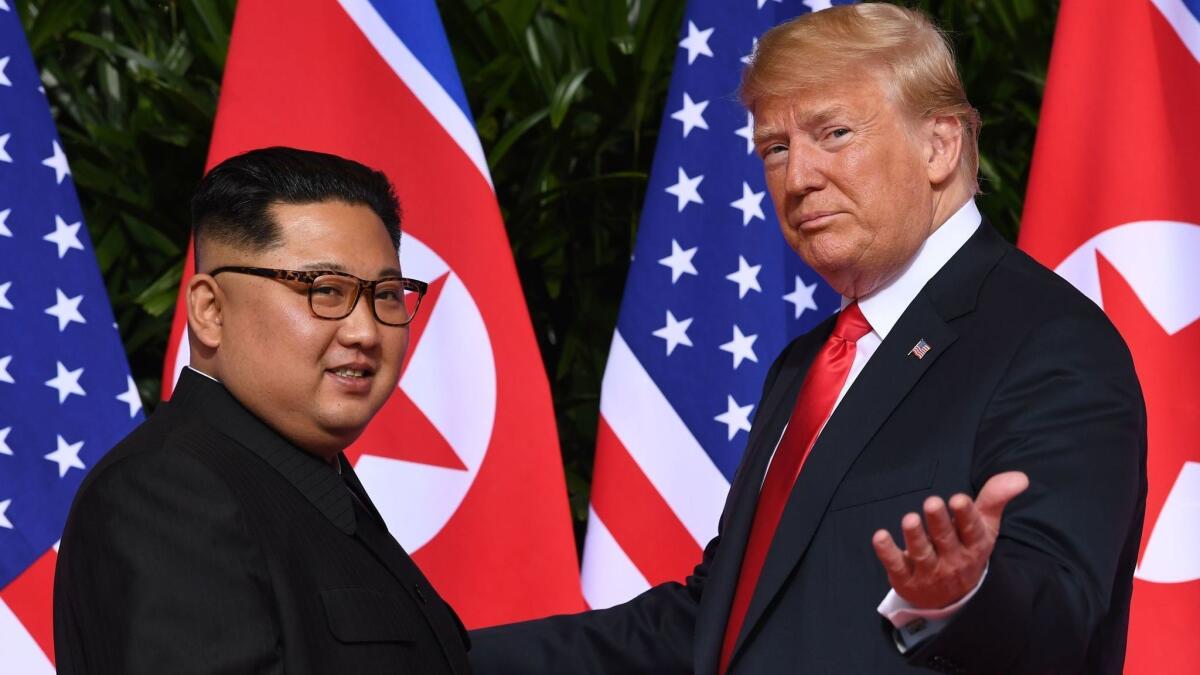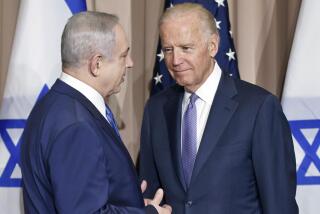Column: Trump’s bromance with Kim Jong Un faces a reality check as the nations discuss nuclear disarmament

Reporting from Washington — Persuading North Korean leader Kim Jong Un to give up his nuclear weapons will be a long and grueling process that will require President Trump to make significant concessions — and even then, the effort may fail.
That dose of caution from Trump’s special envoy to North Korea, delivered as the two leaders prepare for their second summit, may sound like common sense. But it’s an important and welcome shift in the White House approach.
It means the mood swings of the past, from “little rocket man” to supposed “love letters,” may be over and detailed negotiations can now begin.
Even Trump may have caught the normalcy bug. After his first summit with Kim last June, he boasted — incorrectly — that North Korea was “no longer a nuclear threat.” Eight months later, Kim has yet to dismantle any part of his nuclear arsenal.
The president sounds more realistic now. “Decent chance of denuclearization,” he tweeted last month.
That chastened tone reflects White House frustration. After the splashy summit in Singapore, when Trump urged Kim to transform his country into a paradise of beach resorts, U.S. officials pushed for rapid denuclearization talks.
Secretary of State Michael R. Pompeo pressed Pyongyang for a complete list of its nuclear facilities, including secret sites, as a first step. Kim’s aides rejected the request out of hand. The talks went into a freeze and needed months to get back on track.
“They started out by asking for everything, as you always do in negotiations,” Joel S. Wit, a former U.S. diplomat who negotiated with North Korea in the 1990s, told me. “Now it’s about give and take. That’s a change in the right direction.”
The change is being led by the new U.S. envoy, Stephen E. Biegun, a low-key, methodical negotiator who was a National Security Council aide to President George W. Bush.
In a recent speech at Stanford University, Biegun laid out the elements of a strategy that many Korea experts praised as smart and flexible.
He said the Trump administration is still pursuing the goal of a complete and verifiable end to North Korea’s nuclear weapons program. But the U.S. side is no longer demanding a full accounting of Pyongyang’s facilities as a first step, Biegun said.
The only realistic way to achieve denuclearization, he said, is through gradual, confidence-building measures on both sides — including some from the United States, to “see if we can change the trajectory of their policies by changing the trajectory of our own.”
That will include efforts to reassure Kim Jong Un that the United States is not a threat to his regime even though the two countries are still technically at war since the 1950-53 conflict ended with an armistice but no peace treaty.
“President Trump is ready to end this war,” Biegun said. “It is over. It is done. We are not going to invade North Korea. We are not seeking to topple the North Korean regime.”
Importantly, Biegun said it’s time to move the talks from noisy televised summits to quiet meetings between lower-level diplomats. That may not sound like much, but the two countries haven’t managed it so far — and diplomats say it’s the only way the effort can succeed.
North Korea has signaled it may be willing to move forward.
After testing an intercontinental ballistic missile and its most powerful nuclear bomb yet in Trump’s first year in office, Pyongyang hasn’t conducted another test since late 2017. And on New Year’s Day, Kim said in a speech that the testing freeze is intended to be permanent.
Pyongyang isn’t disarming yet. The regime is still producing nuclear weapons material, according to U.S. intelligence; it wants to keep its arsenal as a deterrent against attacks.
That’s why North Korea refused to provide a list of nuclear facilities; it didn’t want the U.S. Air Force to know where they are.
Because of the mutual suspicion, researchers at Stanford have estimated that denuclearization will take at least 10 years even if negotiations are successful.
The next opportunity to move forward will be the Hanoi summit, scheduled for Feb. 27-28. Trump has told the North Koreans that he wants “actions that are bold and real,” Biegun said.
That might include steps to dismantle Pyongyang’s long-range ballistic missiles, the most direct threat to the United States, and for international inspections of nuclear sites North Korea says it has closed.
In return, Trump may declare that the U.S. considers the Korean War over — not a formal peace treaty, which could take years to conclude, but a simple promise not to attack.
Kim will want economic sanctions eased. Trump is unlikely to lift any U.S. sanctions but could support a move to allow South Korea to launch joint economic projects with the north.
Less eye-catching but equally important would be agreement on a “roadmap” for lower-level working groups to outline the next steps and the ones after that. That would mean the two countries are finally getting to work on the boring but essential details of step-by-step disarmament.
Trump will be tempted, as always, to claim spectacular results. But the real accomplishments of the summit, if any, are likely to lie in those seemingly mundane details.
More to Read
Get the L.A. Times Politics newsletter
Deeply reported insights into legislation, politics and policy from Sacramento, Washington and beyond. In your inbox three times per week.
You may occasionally receive promotional content from the Los Angeles Times.











